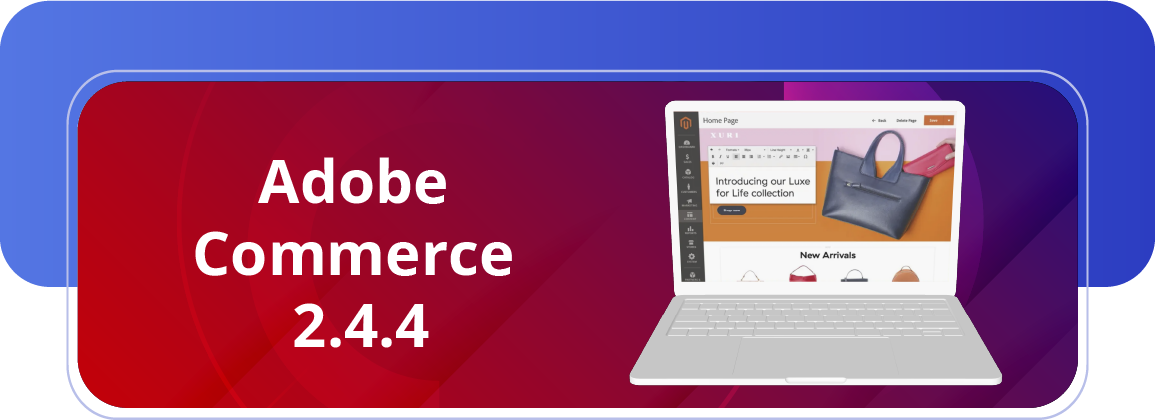Adobe Commerce 2.4.4: moving above and beyond magento

So Magento got another update this month, but it’s more than a regular update- it’s a brand overhaul with some decent updates to the eCommerce platform’s underpinnings. Adobe purchased the Magento Ecommerce Edition in May 2018, and it recently rebranded it as Adobe Commerce, a move that impacts over 189,062 websites.

The experts at i95Dev have curated this blog to help our readers understand the dynamics behind this rebranding exercise. Let’s get started:
Adobe Commerce Cloud 2.4.4 Addresses Multiple Security Concerns
The new release includes patches for three security improvements and bug fixes each apart from security enhancements across the platform through a core codebase upgrade.
Also, it includes security benefits like:
- As a result of security improvisation, session IDs will no longer be stored in the database.
- Non-alpha-numeric file extensions uploading will also become more secure as validation is fortified.
- The coupon codes, too, will get additional support from reCAPTCHA.
- Swagger will be disabled by default.
- Access and password reset tokens will also get encrypted when stored in the database.
- Also, these security patches are backported to Adobe Commerce 2.4.3-p2 and Adobe Commerce 2.3.7-p3 versions.
Performance And Scalability Enhancements
Order validation and cart operations have been optimized for enabling smoother checkout and fulfillment. Also, you will be able to process the orders at a quicker pace, making the overall user experience better for both you and your customers.
- AsyncOrder feature will allow you to process orders in the background while your customers are finishing their checkout.
- You can now enable inventory check for products added to carts.
- You can now allow multiple customers to perform various processes in parallel by adding multiple_processes configuration to your app/etc/env.php file for better task execution speed.
- With hundreds of variable products, carts can now be processed quickly with memory limit expansions.
PayPal Enhancements
- Merchants will now benefit from the built-in Venmo payment inside Paypal.
- Based on geotargeting, customers can now choose to “Pay Later.”
- The customers will be explicitly notified regarding the charges associated with the “Pay Later” option on the checkout page.

Accessibility Updates
- Screen reader support is updated for all relevant Product Page elements.
- Readability is enhanced for low vision users through measures like improved contrast and icon relocation.
- It will become easier to navigate on the Cart and Checkout pages.
- The magnifying glass (used for searching products) will get a text-based alternative and an accessible name.
Cart Enhancements
- The “Advertised Minimum Price” link is fixed and now clickable. It redirects the user towards an information popup.
- Earlier, Adobe Commerce displayed a ‘Payment Error’ message after a ‘Payment Error’ message which is now eliminated.
- If the increased shopping cart product quantity is deemed invalid, the value will be restored to the previous figure to maintain checkout page performance.
Platform Enhancements
- Composer dependencies, including JS libraries like RequireJS, are upgraded to bring the platform to par with PHP 8.1
- On top of that, support has been provided for TinyMCE 5, and PHPUnit is upgraded to 9.5.x
Page Builder Enhancements
- Text editor issues faced while working on banner content are optimized along with table fonts.
- Popup windows like ‘Insert/Edit image’ and ‘Insert/Edit Link’ are now positioned better.
The page builder is expected to receive more frequent updates in the future as it is one of the focus areas of Adobe at the moment.
Additional Enhancements
- You can now successfully add Product Videos through the path Admin Catalog > Products > Add Video. Also, the save button will be enabled when an incomplete URL is added, while the additional fields will get auto-filled.
- The timestamps will now be converted into the user’s time zone in the export filename. Previously, this wasn’t possible, and Adobe only displayed the UTC timestamp.
- Adobe Commerce will not generate duplicate images in its remote storage upon importing CSV files multiple times.
Why You Must Upgrade To Adobe Commerce 2.4.4 ASAP
Despite being around for more than two decades, eCommerce is rapidly evolving while customer behavior is now augmented at a much higher rate. Using the latest version of Adobe Ecommerce will help you on multiple fronts, including the support for PHP 8.1, while you will also benefit from:
- Better integration with Adobe Experience Cloud applications.
- Better tools for your Adobe Ecommerce developers.
- Improved ability to customize your Adobe eCommerce store along with enhanced flexibility.
- Maintenance also becomes quicker and more affordable than the old (Magento) versions.
Summing Up
It is noteworthy that despite the rebranding, Magento Open Source, i.e., Magento Community Edition, will continue to exist as earlier. The updates in the latest version make a strong case for users to upgrade as they also help solve some of the persistent problems faced in the earlier versions. If you are facing any troubles upgrading from older Magento versions to Adobe Commerce 2.4.4, feel free to reach out to us anytime.
How did i95Dev’s project management team help overcome our inventory sync issue.
Recent Blogs
Managing Massive Product Catalogs: Why Synchronization is the Key to Efficiency
Managing Massive Product Catalogs: Why Synchronization is the Key to Efficiency Author Category Share The automotive aftermarket industry is vast and highly competitive, requiring businesses...
A Complete Guide to Seamlessly Integrating Adobe Commerce with NetSuite
A Complete Guide to Seamlessly Integrating Adobe Commerce with NetSuite Author Category Share Integrating Adobe Commerce (formerly Magento) with NetSuite ERP can transform the way businesses...
Why Shopify and NetSuite Integration is Crucial for Your eCommerce Success
Why Shopify and NetSuite Integration is Crucial for Your eCommerce Success Author Category Share The digital transformation of commerce is accelerating. According to Gartner, by 2025, a...



